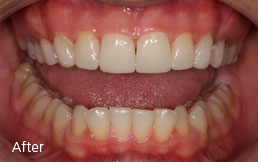What should I have, Composite Veneers or Porcelain Veneers?
- The majority of people would improve their smile if they could.
- In fact 76% of people don’t feel confident smiling.
- 48% of people judge people on their smile and appearance of their teeth.
- 77% of people believe having a great smile helps them mentally and physically.
- 67% of people feel it helps them form relationships and friendships.
Cosmetic dentistry procedures can improve the smile. This really depends on what one wishes to improve, time and budget. Two very popular cosmetic dentistry treatments are porcelain veneers and composite veneers. In this article we discuss these treatments that can dramatically improve your smile.
Porcelain Veneers

After Pic

What is a Porcelain Veneer?
A porcelain veneer is a porcelain laminate custom made to bond to the front surface of a tooth. Porcelain veneers are sometimes compared to false nails as they are very thin cosmetic coverings.
When Do I Need a Porcelain Veneer?
Porcelain veneers are great at improving many dental problems:
- Chipped teeth – can be fixed with Porcelain veneers
- Discoloured teeth – can be made brighter with Porcelain veneers
- Misshapen teeth – porcelain veneers can improve the shape of your teeth and hide ‘ugly’ teeth
- Crowded teeth – If teeth are out of line or too close together, porcelain veneers are an alternative to orthodontics or braces.
- Gappy teeth – porcelain veneers are great at closing gaps between teeth. Teeth proportions can be made perfect.
Advantages of Porcelain Veneers
Porcelain veneers require minimal tooth preparation; hence you conserve as much tooth as possible. Porcelain veneers look very natural and should be much better than what was there before.
Disadvantages of Porcelain Veneers
Tooth preparation is normally required; if teeth are really malpositioned then more preparation may be needed. They are not reversible.
How Are Teeth Prepared For Porcelain Veneers?
Normally between 0.5mm – 0.7mm of tooth is adjusted to give room for the porcelain veneer to fit to the tooth surface without looking bulky.
Tooth preparation depends on how the teeth are originally positioned. Sometimes teeth need no preparation and at other times more to correctly shape the teeth. After the preparation a mould is taken and temporary veneer/s are made. You then return approximately 2 weeks later to have the porcelain veneers bonded to your tooth / teeth. Porcelain veneers usually take two visits to complete.
Temporary Veneers
Temporary veneers are made from resin, they are essential to do accurately as this will give you a good idea of shape / colour of the final porcelain veneers. This gives you time to get used to your new teeth.
Cost of Porcelain Veneers
The cost of porcelain veneers varies, so it is important to discuss this with the cosmetic dentist before starting treatment.
How long do Porcelain Veneers Last?
Porcelain veneers can last you many years.This depends on your hygiene, diet and the health of your existing teeth. Also whether you clench or grind your teeth.
Alternatives to Porcelain Veneers
Cosmetic resin bonding can sometimes be done, but is not as strong or as aesthetic as porcelain veneers. Porcelain crowns can also be used but tend to be reserved for badly broken teeth as they cover all surfaces of the tooth.
Composite Veneers

After Pic

What is a Composite Veneer?
A composite veneer is made of a composite resin filling material. It is placed over the entire front surface of the tooth to improve its aesthetic appearance
When Do I need a composite Veneer?
Similar to porcelain veneers, composite veneers can be used at improving many dental problems:
- Chipped teeth – can be fixed with composite veneers
- Misshapen teeth – composite veneers can improve the shape of your teeth and hide ‘ugly’ teeth
- Crowded teeth – If teeth are out of line or too close together, composite veneers are an alternative to orthodontics or braces.
- Gappy teeth – composite veneers are great at closing gaps between teeth. Teeth proportions can be made perfect.
Advantages of Composite Veneers
Composite veneers require either no or minimal tooth preparation, hence you conserve as much tooth as possible. They are also a cheaper alternative to porcelain veneers.
Only one appointment is needed if you decide to go ahead with composite veneers.
Disadvantages of Composite Veneers
Due to the composite resin material, composite veneers can stain especially if your diet consists of curry, red wine etc.
Composite veneers do not last as long as porcelain veneers and wear and tear is likely to occur.
How long will composite veneers last?
This depends on many factors; the type of composite material used (there is a big difference in the quality of different composite materials); the aftercare and habits (i.e. if you continued to drink a lot of fizzy drinks and grind your teeth then this would reduce their longevity). On average, Composite veneers can last between 2 – 5 years.
Cost of composite veneers
The cost of composite veneers varies, so it is important to discuss this with the cosmetic dentist before starting treatment.
Free consultation
Perfect Smile Spa based in Hornchurch Essex is a Leading cosmetic dental practice and is dedicated to PAINLESS dentistry. We carry out many cosmetic dentistry treatments and have been shortlisted at the Aesthetic Dentistry Awards 2013, 2014 and 2015
Call us for a free consultation on 01708 442 114 or email care@perfectsmilespa.co.ukChoosing Between Porcelain or Composite Veneers? was last modified: July 2nd, 2018 by Dr Jas Sagoo



 132a High Street
132a High Street 01708442114
01708442114  care@perfectsmilespa.co.uk
care@perfectsmilespa.co.uk


